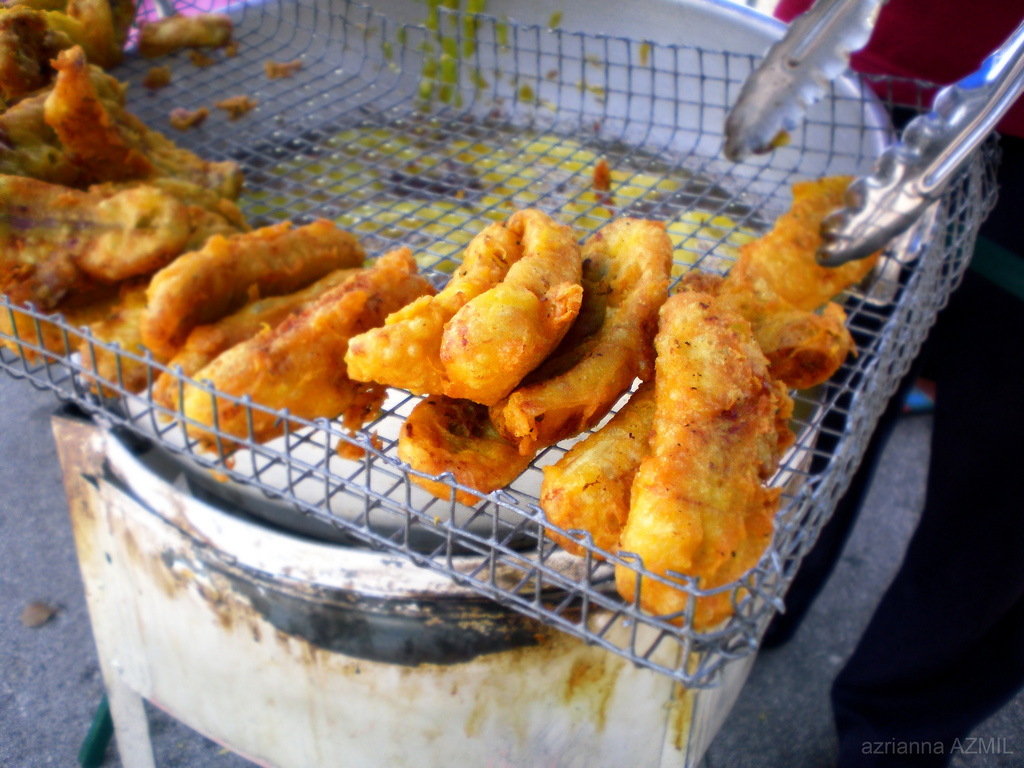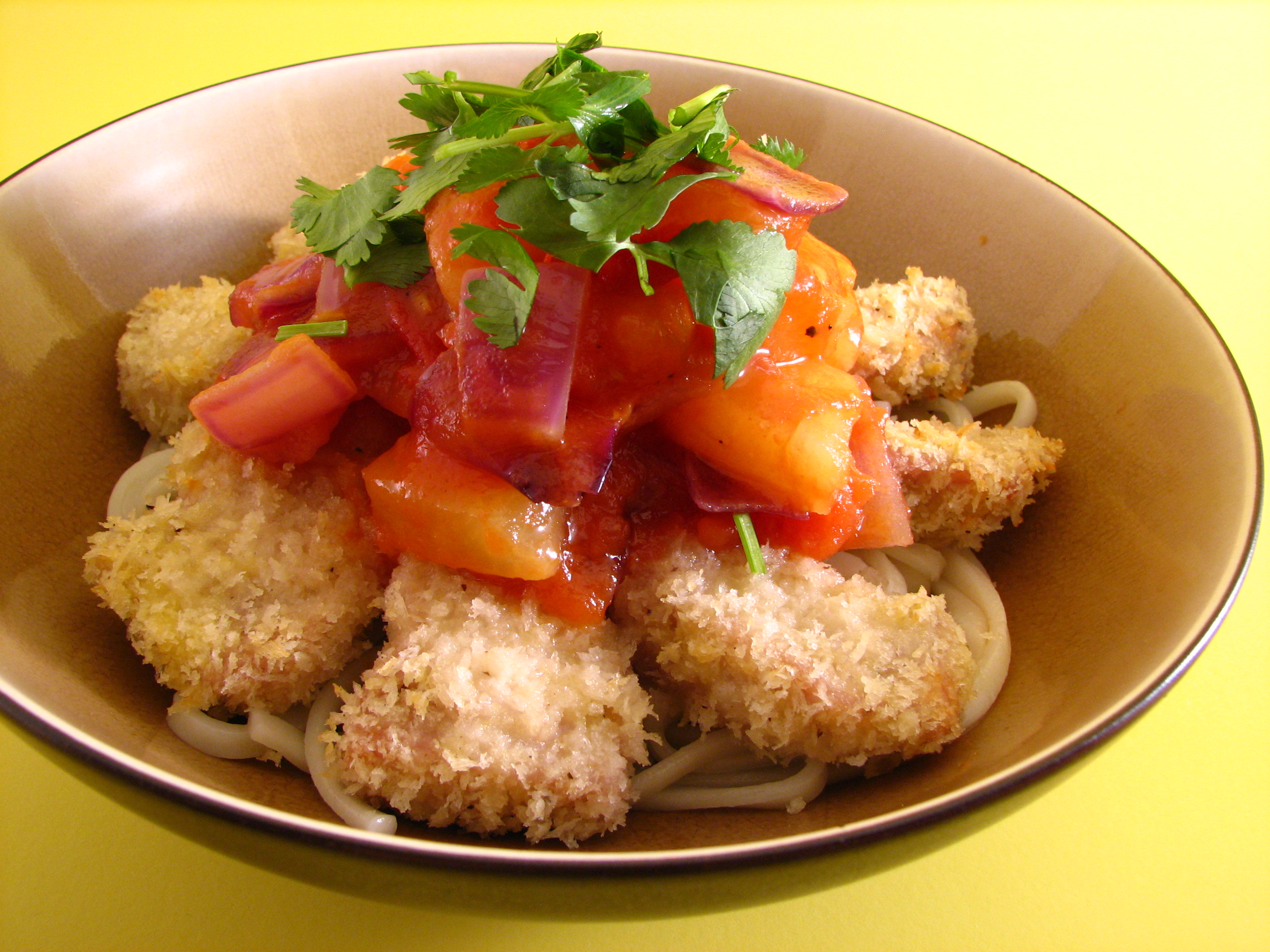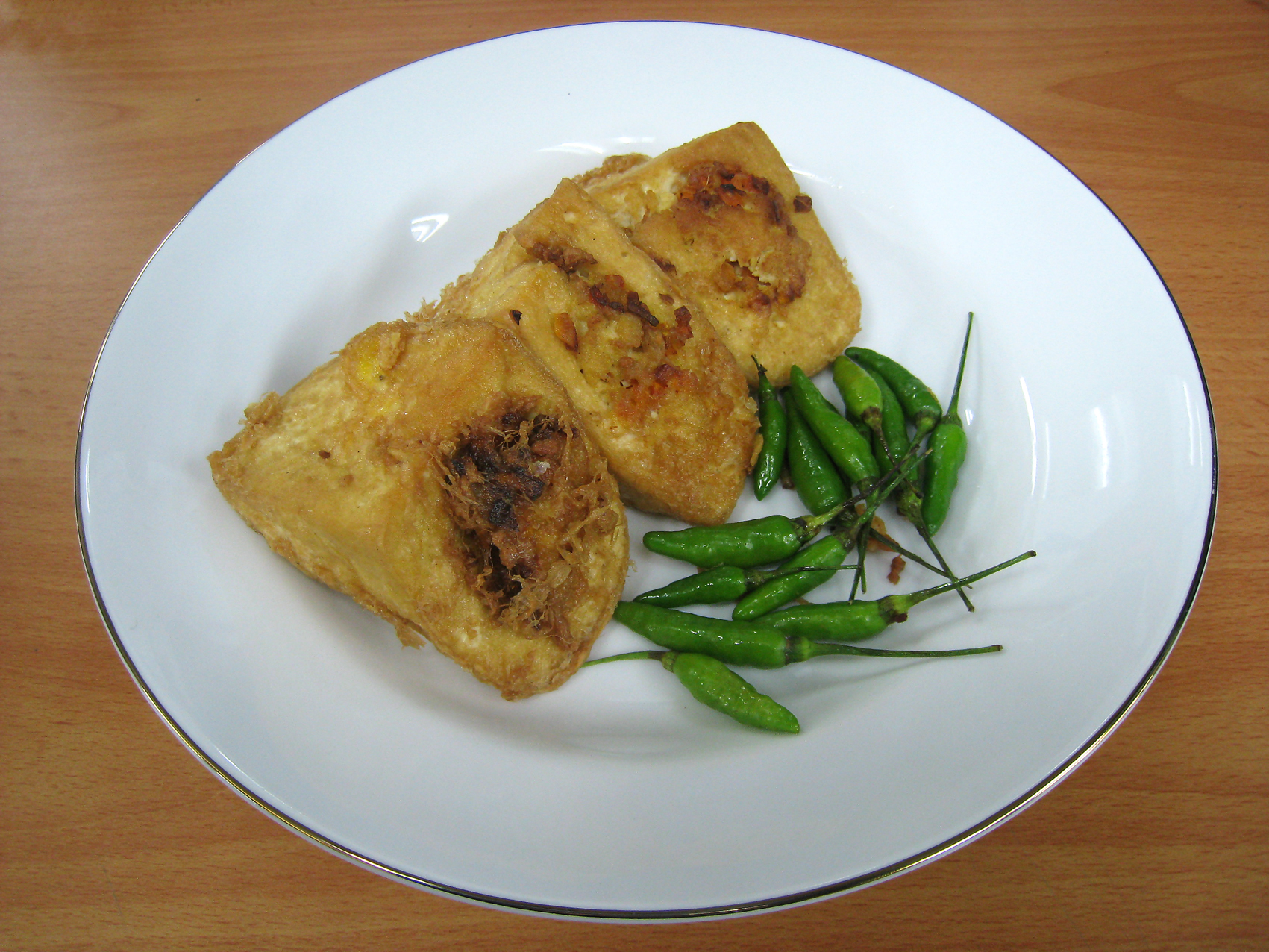|
Fritters
A fritter is a portion of meat, seafood, fruit, vegetables or other ingredients which have been battered or breaded, or just a portion of dough without further ingredients, that is deep-fried. Fritters are prepared in both sweet and savory varieties. Etymology The 1854 edition of ''An American Dictionary of the English Language'' by Noah Webster defines fritter as a transitive verb meaning "to cut meat into small pieces to be fried". Another definition from 1861 is given as "a pancake cont. chopped fruit, poultry, fish; also a small piece of meat fried". Varieties Africa West African countries have many variations similar to fritters. The most common process includes the blending of peeled black-eyed peas with peppers and spices to leave a thick texture. A Yoruba version, akara, is a popular street snack and side dish in Nigerian culture. South Africa Pumpkin fritters, served with cinnamon sugar at any time of day, are popular in South Africa. Asia South Asia Frit ... [...More Info...] [...Related Items...] OR: [Wikipedia] [Google] [Baidu] |
Akara
Àkàrà (Yoruba)(English: Bean cake Hausa: kosai, Portuguese: Acarajé () is a type of fritter made from cowpeas or beans (black eye peas). It is found throughout West African, Caribbean, and Brazilian cuisines. The dish is traditionally encountered in Brazil's northeastern state of Bahia, especially in the city of Salvador. Acarajé serves as both a religious offering to the gods in the Candomblé religion and as street food. The dish was brought by enslaved peoples from West Africa, and can still be found in various forms in Nigeria, Ghana, Togo, Benin, Mali, Gambia, Burkina Faso and Sierra Leone. Akara is an African cuisine that originated from the Yoruba culture, it is made from peeled beans (black eye peas), washed and ground with pepper, and other preferred seasonings, then beaten to aerate them, and deep fried in small balls. Brazilian acarajé is made from cooked and mashed Cowpea, cowpeas that are seasoned with salt and chopped onions molded into the shape of a large ... [...More Info...] [...Related Items...] OR: [Wikipedia] [Google] [Baidu] |
Banana Fritter
A banana fritter is a fritter made by deep frying battered banana or Cooking banana, plantain in hot oil. It is a common dish across Cuisine of Southeast Asia, Southeast Asia and South India,Kerala. Varieties Brunei Banana fritters are a traditional snack in Brunei, where they are called . They are similar to ''pisang goreng'' in #Indonesia, Indonesia and #Malaysia, Malaysia. , a variant of made with honey, are popular as a light afternoon meal (). Cambodia In Khmer language, Khmer, banana fritters are called ''num chek chien'' (). They are made by dipping flattened bananas in a thick mixture of rice flour, sesame seeds, egg whites and coconut milk seasoned with salt and sugar and deep frying them in hot oil until crispy and golden. The Cambodian banana fritters are more savoury than sweet and are often eaten as a snack with coconut ice cream as a popular accompaniment. A famous banana fritter shop in Cambodia is ''Chek Chean Pises'' operating since 2000 that has two location ... [...More Info...] [...Related Items...] OR: [Wikipedia] [Google] [Baidu] |
Pisang Goreng
A banana fritter is a fritter made by deep frying battered banana or plantain in hot oil. It is a common dish across Southeast Asia and South India,Kerala. Varieties Brunei Banana fritters are a traditional snack in Brunei, where they are called . They are similar to ''pisang goreng'' in Indonesia and Malaysia. , a variant of made with honey, are popular as a light afternoon meal (). Cambodia In Khmer, banana fritters are called ''num chek chien'' (). They are made by dipping flattened bananas in a thick mixture of rice flour, sesame seeds, egg whites and coconut milk seasoned with salt and sugar and deep frying them in hot oil until crispy and golden. The Cambodian banana fritters are more savoury than sweet and are often eaten as a snack with coconut ice cream as a popular accompaniment. A famous banana fritter shop in Cambodia is ''Chek Chean Pises'' operating since 2000 that has two locations in Phnom Penh – at Mao Tse Tong Boulevard and Kampuchea Krom Boulevard. So ... [...More Info...] [...Related Items...] OR: [Wikipedia] [Google] [Baidu] |
Cucur Pisang
A banana fritter is a fritter made by deep frying battered banana or plantain in hot oil. It is a common dish across Southeast Asia and South India,Kerala. Varieties Brunei Banana fritters are a traditional snack in Brunei, where they are called . They are similar to ''pisang goreng'' in Indonesia and Malaysia. , a variant of made with honey, are popular as a light afternoon meal (). Cambodia In Khmer, banana fritters are called ''num chek chien'' (). They are made by dipping flattened bananas in a thick mixture of rice flour, sesame seeds, egg whites and coconut milk seasoned with salt and sugar and deep frying them in hot oil until crispy and golden. The Cambodian banana fritters are more savoury than sweet and are often eaten as a snack with coconut ice cream as a popular accompaniment. A famous banana fritter shop in Cambodia is ''Chek Chean Pises'' operating since 2000 that has two locations in Phnom Penh – at Mao Tse Tong Boulevard and Kampuchea Krom Boulevard. Sout ... [...More Info...] [...Related Items...] OR: [Wikipedia] [Google] [Baidu] |
Bhajji
Pakora () is a spiced fritter originating from the Indian subcontinent. They are sold by street vendors and served in restaurants in South Asia and UK. It consists of items, often vegetables such as potatoes and onions, coated in seasoned gram flour batter and deep fried. The pakora is known also under other spellings including pikora, pakoda, pakodi and regional names such as bhaji, bhajiya, bora, ponako, and chop. Etymology The word ''pakoṛā'' is derived from Sanskrit पक्ववट ''pakvavaṭa'', a compound of ''pakva'' ('cooked') and '' vaṭa'' ('a small lump') or its derivative ''vaṭaka'', 'a round cake made of pulse fried in oil or ghee'. Some divergence of transliteration may be noted in the third consonant in the word. The sound is a hard 'da' in the Telugu language and the 'ra' sound would be an incorrect pronunciation. The sound is the retroflex flap , which is written in Hindi with the Devanagari letter ड़, and in Urdu with letter ڑ. However, in ... [...More Info...] [...Related Items...] OR: [Wikipedia] [Google] [Baidu] |
Pakora
Pakora () is a spiced fritter originating from the Indian subcontinent. They are sold by street vendors and served in restaurants in South Asia and UK. It consists of items, often vegetables such as potatoes and onions, coated in seasoned gram flour batter and deep fried. The pakora is known also under other spellings including pikora, pakoda, pakodi and regional names such as bhaji, bhajiya, bora, ponako, and chop. Etymology The word ''pakoṛā'' is derived from Sanskrit पक्ववट ''pakvavaṭa'', a compound of ''pakva'' ('cooked') and '' vaṭa'' ('a small lump') or its derivative ''vaṭaka'', 'a round cake made of pulse fried in oil or ghee'. Some divergence of transliteration may be noted in the third consonant in the word. The sound is a hard 'da' in the Telugu language and the 'ra' sound would be an incorrect pronunciation. The sound is the retroflex flap , which is written in Hindi with the Devanagari letter ड़, and in Urdu with letter ڑ. However, in t ... [...More Info...] [...Related Items...] OR: [Wikipedia] [Google] [Baidu] |
Onion Bhaji
A bhaji is a type of fritter originating from the Indian subcontinent. It is made from spicy hot vegetables, commonly onion, and has several variants. It is a popular snack food in India, it is also very popular in Pakistan, and Trinidad and Tobago, and it can be found for sale in street-side stalls, especially in '' tapris'' (Marathi: टपरी) (on streets) and ''dhabas'' ( Punjabi: ਢਾਬਾ) (on highways). It is also a common starter in Anglo-Indian cuisine across the United Kingdom. The Guinness World Record for the largest onion bhaji is held by one weighing made by Oli Khan and Team of Surma Takeaway Stevenage on the 4th of February 2020. Regional varieties Outside Southern and Western India, such preparations are often known as ''pakora''. Its variations include the chili bajji, potato bajji, onion bajji, plantain bajji and the bread bajji (or bread pakoda). Another version is called bonda (in south India), vada (in Maharashtra) and Gota (in Gujarat). Bonda ... [...More Info...] [...Related Items...] OR: [Wikipedia] [Google] [Baidu] |
Batter (cooking)
Batter is a flour mixture with liquid and other ingredients such as sugar, salt and leavening agent, leavening used for cooking. It usually contains more liquid than doughs, which are also mixtures of flour and liquid. Batters are usually a pourable consistency that can't be kneaded. Batter is most often used for pancakes, light cakes, and as a coating for fried foods. It is also used for a variety of batter breads. The word ''batter'' comes from the French word ''battre'', which means ''to beat'', as many batters require vigorous beating or whisking in their preparation. Methods Many batters are made by combining dry flours with liquids such as water, milk or egg as food, eggs. Batters can also be made by soaking grains in water and grinding them wet. Often a leavening agent such as baking powder is included to aerate and fluff up the batter as it cooks, or the mixture may be naturally Fermentation (food), fermented for this purpose as well as to add flavour. Carbonated water ... [...More Info...] [...Related Items...] OR: [Wikipedia] [Google] [Baidu] |
Black-eyed Pea
The black-eyed pea or black-eyed bean is a legume grown around the world for its medium-sized, edible bean. It is a subspecies of the cowpea, an Old World plant domesticated in Africa, and is sometimes simply called a cowpea. The common commercial variety is called the California Blackeye; it is pale-colored with a prominent black spot. The American South has countless varieties, many of them heirloom, that vary in size from the small lady peas to very large ones. The color of the eye may be black, brown, red, pink, or green. All the peas are green when freshly shelled and brown or buff when dried. A popular variation of the black-eyed pea is the purple hull pea or mud-in-your-eye pea; it is usually green with a prominent purple or pink spot. The currently accepted botanical name for the black-eyed pea is ''Vigna unguiculata'' subsp. ''unguiculata'', although previously it was classified in the genus '' Phaseolus''. ''Vigna unguiculata'' subsp. ''dekindtiana'' is the wild relat ... [...More Info...] [...Related Items...] OR: [Wikipedia] [Google] [Baidu] |
Deep-frying
Deep frying (also referred to as deep fat frying) is a cooking method in which food is submerged in hot fat, traditionally lard but today most commonly oil, as opposed to the shallow oil used in conventional frying done in a frying pan. Normally, a deep fryer or chip pan is used for this; industrially, a pressure fryer or vacuum fryer may be used. Deep frying may also be performed using oil that is heated in a pot. Deep frying is classified as a hot-fat cooking method. Typically, deep frying foods cook quickly: all sides of the food are cooked simultaneously as oil has a high rate of heat conduction. The term "deep frying" and many modern deep-fried foods were not invented until the 19th century, but the practice has been around for millennia. Early records and cookbooks suggest that the practice began in certain European countries before other countries adopted the practice. Deep frying is popular worldwide, with deep-fried foods accounting for a large portion of global ca ... [...More Info...] [...Related Items...] OR: [Wikipedia] [Google] [Baidu] |
Breading
Bread crumbs or breadcrumbs (regional variants including breading and crispies) consist of crumbled bread of various dryness, sometimes with seasonings added, used for breading or crumbing foods, topping casseroles, stuffing poultry, thickening stews, adding inexpensive bulk to soups, meatloaves and similar foods, and making a crisp and crunchy covering for fried foods, especially breaded cutlets like tonkatsu and schnitzel. The Japanese variety of bread crumbs is called ''panko''. Types Dry Dry breadcrumbs are made from dry breads which have been baked or toasted to remove most remaining moisture, and may have a sandy or even powdery texture. Bread crumbs are most easily produced by pulverizing slices of bread in a food processor, using a steel blade to make coarse crumbs, or a grating blade to make fine crumbs. A grater or similar tool will also do. Fresh The breads used to make soft or fresh bread crumbs are not quite as dry, so the crumbs are larger and produce a softer ... [...More Info...] [...Related Items...] OR: [Wikipedia] [Google] [Baidu] |
Tahu Goreng
Tahu goreng ( Indonesian spelling) or Tauhu goreng (Malaysian and Singaporean spelling) is a generic name for any type of fried tofu dish in the cuisines of Indonesia, Malaysia and Singapore. Preparation When preparing the dish, cakes of hard tofu are deep fried until golden brown. A popular way to serve fried tofu is to cut them diagonally in half and arranged on a plate garnished with bean sprouts, cucumber and scallion. A thick sauce is prepared with shallots, garlic, chili peppers, shrimp paste, soy sauce and tamarind juice. Cultural origins In Malay language and Indonesian; ''tauhu'' or ''tahu'' refers to 'tofu' and ''goreng'' indicates 'fried'. Tofu originated from China and brought to Southeast Asia by Chinese immigrants to the region. Its first arrival in Indonesia is estimated through the Khubilai Khan's army in Kediri at 1292. Fried tofu is consumed extensively in Asian cultures and has found its way into mainstream Western vegetarian diets. Variations Indonesia ... [...More Info...] [...Related Items...] OR: [Wikipedia] [Google] [Baidu] |








